User:Bicycle tourer/Confluences
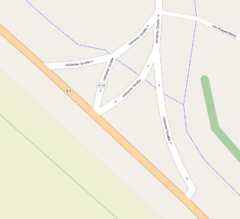
|
| Description |
| A place, where one road merges into another |
| Group |
| Tags |
|
This is a proposal. For background, motivation, terms see talk page
Confluences in reality
Confluences are a special type of junction and exist in many different forms.
The one common thing to all confluences: A place, where one road merges into another (more specific: where road M (merging road) merges into road R (receiving road)). The receiving road R might be divided into two pieces R1 and R2, but can be identified as belonging together and building R together by having the same official identifier (e.g. "B 10"), represented in ref=* or in some cases by the same name (e.g. "Coit Road"), represented in name=*. Two types of roads must not be part of a confluence: motorway (highway=motorway) and trunk (highway=trunk). But they generate motorway links (highway=motorway_link) and trunk links (highway=trunk_link) at their exits, and those can be part of a confluence.
The involved roads (M and R) might have different arrangements (e.g. separate carriageways for each direction, links or no links etc.), this is discussed below in types of confluences.
In many simple cases confluences can be seen as T-Junctions (aka 3-way-junctions), but below are examples where a confluence is interpreted differently from a T-Junction. In more complex confluences M and R consist of several involved ways (similar to a circular consisting of several ways). In such cases all parts of the merging road M have the same classification independent whether they are a link or "not a link" (e.g. all are highway=secondary or highway=secondary_link). Therefore confluences determine classification of involved highways and links.
For lower classified roads (e.g. residential, service etc.) it's tricky to determine whether its a confluence or a Y-junction (Wikipage tbd): While a residential (highway=residential) still might have a common name name=*, service roads (highway=service) and lower might not even have a name. In these cases assume it to be a Y-junction and not a confluence. But even if you get it wrong for these cases the comprehensive case distinction table leads to the same results as if it were a Y-junction. Furthermore there are cases where cycleways or footways seem to merge into a road, but this is only because they have been mapped separately (parallel with road) and become part of the road (by sidewalk=* or cycleway=* or even implicitely) at this point. Obviously this is not a confluence.
Last not least not all types of highways can play any type of role in a confluence. Motorway and trunk themselves must not be part in general, for other types it depends, have a look at case distinction table which cases work.
Types of confluences
There are four criteria differentiating different types of confluences:
- Number of carriageways of merging road and how they are arranged (1 or 2)
- Number of links from merging road to receiving road (0, leaving, entering, leaving+entering)
- Number of carriageways of receiving road (1 or 2)
- How the connection between the carriageways of receiving road is built.
You can see in detail, which types of confluences evolve out of these criteria in Confluence Types Reference.
As you can see: For the type of confluence it does not matter, what the classification of merging or receiving roads is (this gets important for the classification of links, see below or this table (more detailed).
How to map a confluence
See Editing Standards and Conventions#Junctions for editing basics.
The following rules describe the preferred way how to map a confluence. There might be specific local situations, where a different tagging is needed, but in those cases the reasons should be documented in note=* for each element which differs from this preferred tagging scheme.
Simple confluences
As long as there are no separate carriageways and no links, it's easygoing, If you are not sure whether a certain type of merging road can merge into a type of receiving road, check this table. All tags are assigned as described in highways.
Mapping links in confluences
Links can only appear from the merging road to the (nearer) carriageway of receiving road (the leaving link) or from the (nearer) carriageway of the receiving road to the merging road (the entering link). A link can only appear if there are two carriageways for one direction, whereas the carriageway nearer to carriageways for opposite direction or including lanes for the opposite direction is treated as the main carriageway, while the other carriageway (more far from opposite direction lanes) is treated as the link.
- Links must be oneway=yes and have the right direction.
- They always have the same classification as the merging road, independent from receiving road (e.g. if merging road is highway=secondary, link hast to be highway=secondary_link. Because of former more generic rules people might have classified differently, but this is deprecated.
- They get a ref=* similar to the merging road (M), because they are treated as part of the merging road (preferred). Some people tag them without {{tag|ref|}, but this is deprecated.
- Leaving link gets a tag {{tag|destination:ref) similar to ref=* of receiving road (R).
- Entering link gets a tag {{tag|destination:ref) similar to ref=* of merging road (M).
- Links get the same name=* as the merging road M, except there is a specific situation assigning them other names (please add note=* for every exceptional element).
- If merging road has an alt_name=* it might make sense to assign the same alternative name to the link, but this depends from the specific situation. However it is good practice to explain in note=* why there is an alternative name.
- If merging road has an old_name=* it might make sense to assign the same old name to the link, but this depends from the specific situation. However it is good practice to explain in note=* why there is an old name.
- All other types of tags are assigned according to highways.
- Turn-restrictions: There are two situations where a turn restriction might be needed: If the leaving link merges into a carriageway holding both directions traffic or if an entering link splits from a carriageway holding traffic of both directions.
Edit-remark: There is a chapter under open issues in talk regarding these rules: Chapter "A_link_or_not_a_link".
Mapping dual main carriageways in merging road
Independent from potential links the main road might be either one carriageway or two. There are two, if they do not hold traffic with opposite directions. If there is a carriageway with traffic for both directions, this is the only single main carriageway. If there is more than one carriageway for traffic with same direction, one of the two (the outer) is a link, see above. Here is how dual carriageways for merging roads are mapped:
- They must be oneway=yes and have the right direction.
- They keep the same classification as the merging road as a whole, independent from receiving road.
- They keep the ref=* from the merging road (M).
- Leaving carriageway gets a tag {{tag|destination:ref) similar to ref=* of receiving road (R)
- Entering carriageway gets a tag {{tag|destination:ref) similar to ref=* of merging road M
- Both carriageways keep the same name=* as the merging road M (sometimes the specific situation might afford the merging road to have another name in the area of the confluence).
- If merging road has an alt_name=* it might make sense to assign the same alternative name to the two main carriageways, but this depends from the specific situation. However it is good practice to explain in note=* why there is an alternative name.
- If merging road has an old_name=* it might make sense to assign the same old name to the two main carriageways, but this depends from the specific situation. However it is good practice to explain in note=* why there is an old name.
- All other types of tags are assigned according to highways
- The final merge of the two carriageways into the (nearer) carriageway of the receiving road can be in one common node or two separate nodes.
- A turn restriction is needed at the place where the carriageways of the merging road join the receiving road
- if the two merging carriageways join in a common node
- if the receiving road is not oneway
- Furthermore a turn restriction is needed where the two separate carriageways merge together a little bit away from the confluence (if they merge).
Mapping single main carriageways in merging road
There is nothing special with them, they are mapped as if there were no links, as simple confluences.
Mapping dual carriageways in receiving road
It the the receiving road has dual carriageways, the connection between the node where the merging road joins the first carriageway of receiving road and the second carriageway can be mapped in several ways:
- There is only one connection, being used in both directions. This includes that the main carriageways of the merging road merge into one node, where the connection starts (Startnode). Such a connection is mapped in the following way:
- It is not a link, but a main road
- It gets the same classification as the merging road, independent from receiving road (e.g. if merging road is highway=secondary, the connection has to be highway=secondary.
- It gets a ref=* similar to the merging road (M), because it is treated as part of the merging road (preferred). Some people tag them without {{tag|ref|}, but this is deprecated.
- It gets the same name=* as the merging road M, except there is a specific situation affording something different (please explain in note=*).
- If merging road has an alt_name=* it might make sense to assign the same alternative name to the connection, but this depends from the specific situation.
- If merging road has an old_name=* it might make sense to assign the same old name to the connection, but this depends from the specific situation.
- All other types of tags are assigned depending from the specific situation, see highways.
- Turn restrictions are probably needed for the whole connection to avoid U-turns between the different carriageways of the receiving road, except you know explicitly they are allowed.
- There are two connections.
- First of all check, whether this might be a turnabout in reality. If yes, stop here and go to roundabouts.
- Both connections are not a link, but a main road.
- They both get the same classification as the merging road, independent from receiving road (e.g. if merging road is highway=secondary, both connections have to be highway=secondary.
- They must be oneway=yes and have opposite directions.
- They both get a ref=* similar to the merging road (M), because they are treated as part of the merging road (preferred). Some people tag them without {{tag|ref|}, but this is deprecated.
- They both get the same name=* as the merging road M, except there is a specific situation affording something different (please explain in note=*).
- If merging road has an alt_name=* it might make sense to assign the same alternative name to the connections, but this depends from the specific situation. It is good practice to explain in note=* if there is an alternative name.
- If merging road has an old_name=* it might make sense to assign the same old name to the connection, but this depends from the specific situation. It is good practice to explain in note=* if there is an old name.
- All other types of tags are assigned according to highways.
Examples for confluences
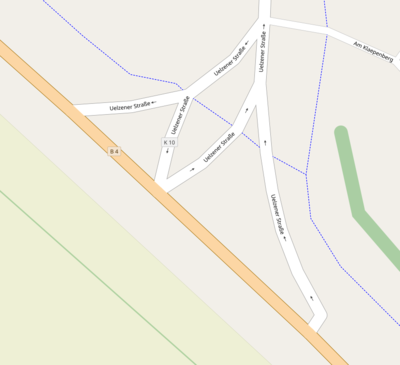
|
Example 1: Confluence with dual carriageways road merging into single carriageway road, two links (leaving + entering)
|
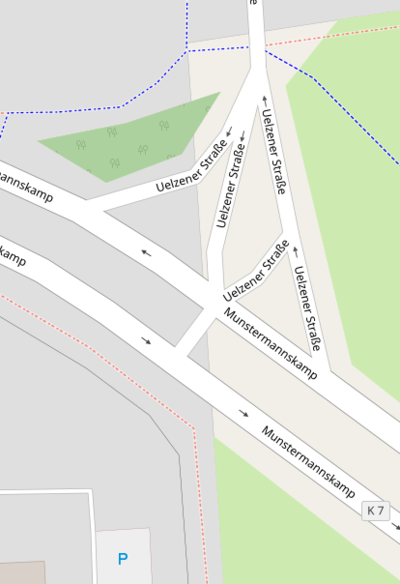
|
Example 2: Confluence with separate carriageways and links
|

|
Example 3: Single carriageway road merging into dual carriageways road with single connection, no links at all
|
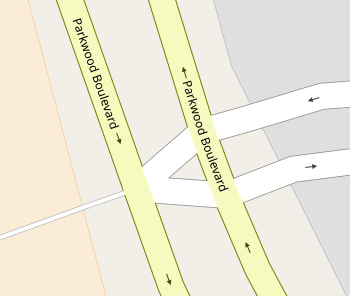
|
Example 4: Confluence with separate carriageways but no links
|
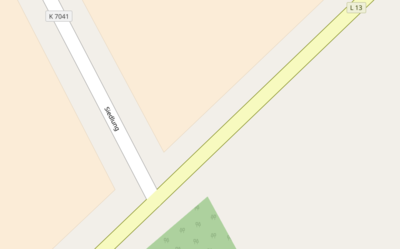
|
Example 5: Simple confluence (single carriageway road merging into single carriageway road, no links)
|
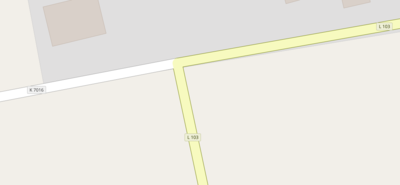
|
Example 6: Bending confluence (single carriageway road merging into single carriageway road, no links)
|
| File tbd | Template for further rows
|
Distinguishing confluences from other junctions
Junctions are NOT a confluence if
- One of the involved ways is part of a roundabout (has tag junction=roundabout)
- One of the involved ways is part of a circular (has tag junction=circular)
- The node where the roads merge is a mini roundabout (has tag highway=mini_roundabout)
- The node where the roads merge is a turning circle (has tag highway=turning_circle)
- The node where the roads merge is a turning loop (has tag highway=turning_loop)
Two confluences in one junction
A junction might be two confluences in parallel, e.g. a merging residential from one side, a service road merging from the other side. This is an abstract view to be able to decide, which classification links will get. You still have to map the streets as they are.
Trivia
Confluence means that road M merges into road R. Obviously road R has to start somewhere else and end somewhere else. A place, where road M ends and road R starts (can be seen as road M mutates to road R) is not a confluence.